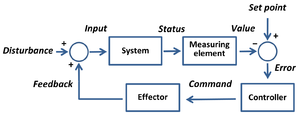目标值
目标值(target)也称为设定值(setpoint,简称SP)或参考值(reference),是模控学及控制理论中的名词,是指系统想要达到的状态[1],常用来描述系统标准的组态[2]。变数相对其目标值的偏离量是以误差为准的控制系统的基础[3],会利用回授的方式使系统回到其稳态。例如一个锅炉有其温度设定值,也就是锅炉控制系统希望锅炉维持的温度。
相关条目
- 程序控制
- PID控制器
- 程序变数
参考资料
- ^ An 'essential variable' is defined as "a variable that has to be kept within assigned limits to achieve a particular goal": Jan Achterbergh, Dirk Vriens. §2.3 Cybernetics: Effective methods for the control of complex systems. Organizations: Social Systems Conducting Experiment. Springer Science & Business Media. 2010: 47. ISBN 9783642143168.
- ^ B. Wayne Bequette. Process Control: Modeling, Design, and Simulation. Prentice Hall Professional. 2003: 5. ISBN 9780133536409.
- ^ W. Ross Ashby. Chapter 12: The error-controlled regulator. Introduction to cybernetics (PDF). Chapman & Hall Ltd.; Internet (1999). 1957: 219–243 [2015-01-08]. (原始内容存档 (PDF)于2018-02-19).
